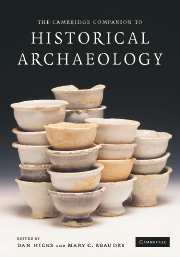Book contents
- Frontmatter
- Dedication
- Contents
- List of figures
- List of tables
- List of contributors
- Acknowledgements
- List of abbreviations
- 1 Introduction: the place of historical archaeology
- PART I ARCHAEOLOGY AND HISTORY
- PART II KEY THEMES IN HISTORICAL ARCHAEOLOGY
- PART III HISTORICAL ARCHAEOLOGY AND MATERIAL CULTURE
- PART IV HISTORICAL ARCHAEOLOGY AND LANDSCAPES
- PART V HISTORICAL ARCHAEOLOGY AND BUILDINGS
- 15 Historical archaeology and buildings
- 16 Household archaeology, identities and biographies
- 17 Afterword: historical archaeology in the wider discipline
- References
- Index
15 - Historical archaeology and buildings
from PART V - HISTORICAL ARCHAEOLOGY AND BUILDINGS
Published online by Cambridge University Press: 05 July 2015
- Frontmatter
- Dedication
- Contents
- List of figures
- List of tables
- List of contributors
- Acknowledgements
- List of abbreviations
- 1 Introduction: the place of historical archaeology
- PART I ARCHAEOLOGY AND HISTORY
- PART II KEY THEMES IN HISTORICAL ARCHAEOLOGY
- PART III HISTORICAL ARCHAEOLOGY AND MATERIAL CULTURE
- PART IV HISTORICAL ARCHAEOLOGY AND LANDSCAPES
- PART V HISTORICAL ARCHAEOLOGY AND BUILDINGS
- 15 Historical archaeology and buildings
- 16 Household archaeology, identities and biographies
- 17 Afterword: historical archaeology in the wider discipline
- References
- Index
Summary
The emphasis upon buildings in the present volume – which includes chapters on the archaeology of cities and households as well as this chapter on buildings archaeology – will surprise some historical archaeologists. For many, studying the historical built environment is the field of architectural and art historians, historical geographers or local historians, and the buried remains of structures encountered by archaeologists are often seen as of less significance than the artefacts recovered from buried deposits associated with them. Thus, the study of buildings is virtually invisible in some overviews of historical archaeology (e.g. Orser and Fagan 1995), the field instead being explored in surveys of vernacular architecture studies (e.g.Glassie 2000; Lanier and Herman 1997). For others, aware of the importance of a more integrated archaeology of buildings, whether in interpretations of Neolithic Europe (Hodder 1990) or descriptions of medieval Britain (Platt 1990; Grenville 1997), such perspectives appear strangely limited. Moreover, despite the relative silence on the study of buildings in mainstream literature on historical archaeology, building remains – whether surviving above ground or below ground as wall foundations, floor surfaces or post holes – have been a major focus in research and cultural-resource management by historical archaeologists around the world, employing a diversity of perspectives and with a range of methods, over the past forty years.
This chapter takes stock of some of this material. We argue that built structures represent a highly significant part of the material remains of the past five hundred years, the study of which deserves to be integrated with the analysis of sites, artefacts and landscapes. We view the field's potential for transdisciplinary contributions to studies of relationships of humans with the built environment as a significant opportunity. Considering the diversity of work in historical archaeology, the chapter provides a brief sketch of the emergence of the study of buildings by historical archaeologists working in two regions: the eastern United States and the United Kingdom. Some of the distinctive interpretive approaches through which historical archaeologists have built upon such studies are then discussed. In a final section archaeological alternatives to the ‘bounded’ study of buildings, especially through biographical and relational approaches that explore distributions across time and space, are explored.
Information
- Type
- Chapter
- Information
- The Cambridge Companion to Historical Archaeology , pp. 273 - 292Publisher: Cambridge University PressPrint publication year: 2006
Accessibility standard: Unknown
- 16
- Cited by
